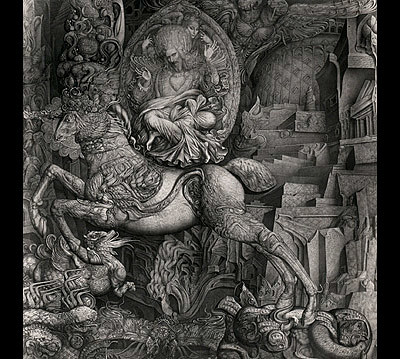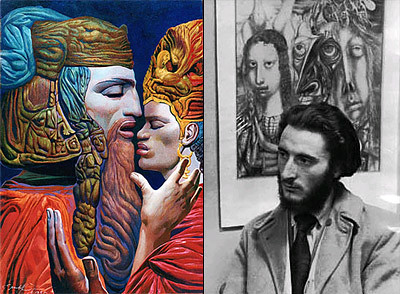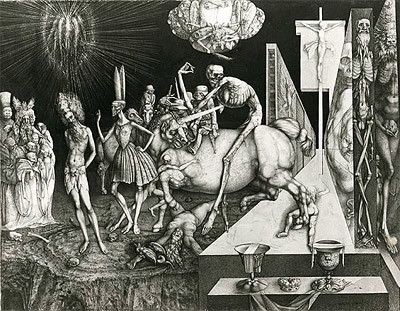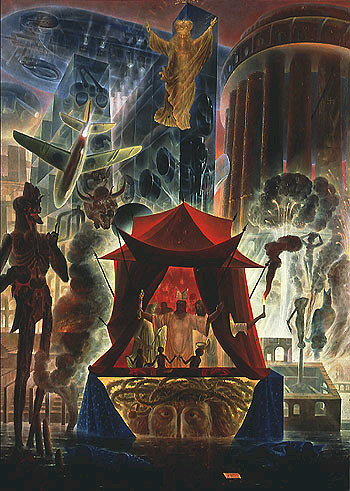Ernst Fuchs: Liebe, Tod und Teufel

“I don’t think that art, if it’s isolated and specialized, can really create culture. It needs a cult.” – Ernst Fuchs
Ernst Fuchs is a man of many talents; he’s taken turns as a painter, draftsman, printmaker, sculptor, architect, stage designer, composer, poet and singer. Born in 1930 and still working today in Vienna, Fuchs is a strong proponent of fantastic and often disturbing art that’s all over the map, thematically and stylistically.

Left: David and Bathshebah. Right: Ernst Fuchs.
Some of Fuchs’ paintings make him look like a deeply religious man, others make it seem like he’s a total heathen. There are the hyper-detailed, religious-themed, Durer-inspired etchings and brush drawings: my favorite of these is Satan’s Heaven, created in 1954, along with Christ Before Pilate and Ahasverus Repudiates Vasthi. Not since Bosch has religion looked so satisfyingly demonic! Parallel to the his tormenting depictions of the Bible, there are many mythological themes: his Procreation of the Unicorn/Temptation of the Unicorn/Triumph of the Unicorn series is not to be missed; unicorn chaser it’s not!
The Christian and Judaic themes in Fuchs’ work come from a very deep place. His father, Maximilian, was the son of an Orthodox Jewish family and had turned down a career as a Rabbi, leaving his theological studies uncompleted. His mother, Leopoldine, was Christian. When the Nazis occupied Austria in 1938, his father emigrated to Shanghai and Nazi legislation made it illegal for Leopoldine to raise her son alone. Fuchs was deported to a camp for mixed-race children. When this happened, his mother agreed to a formal divorce, which saved Ernst Fuchs from the extermination camp. He was baptised in 1942, an event that would have huge impact on his life and work.

Christ Before Pilate
One of the most interesting aspects of Fuchs’ work, to me, is the range of his feminine portrayal. He’s captured female body horror in his painting A Woman’s Reflection in a Row of Houses so well it makes my stomach turn, yet he can turn around a paint set of clean, pretty Mucha-like images, followed by a sophisticated fetishistic sculpture called Sphinx III that looks like a Michael Manning drawing come to life.

Sphinx III
Like Vrubel and Beksi?ski, Fuchs is not that well-known in America. According to friends, this fact doesn’t bother him much; he’s happy to just continue his work and stay productive. However, he is still revered in much of the art world, and has influenced many well-known artists such as H.R. Giger and Mark Ryden. Most recently, he contributed artwork and a Foreword to the book Metamorphosis, which showcases the work of 50 fantastic/surreal artists.

The Psalm 69

December 26th, 2007 at 10:13 pm
Man, I lubs me some Satan’s Heaven era Fuchs. Had no idea he almost went to the death camps! That really does explain a lot about the religious symbolism in his work.
December 26th, 2007 at 10:16 pm
I may be forced into going offline for a bit, und missing CoilHouse will undoubtedly be something of a blow.
December 26th, 2007 at 10:22 pm
Aww! Don’t worry Jerem, we’ll be here when you get back. Best of luck.
December 26th, 2007 at 10:53 pm
I really like Fuchs’s work in general, but especially his black-and-white Durer-inspired work (this is easily explained by the fact that Durer has been one of my favorite artists since I first saw Melancolia I sometime in elementary school, he is one of the two artists who I think are largely responsible for me falling in love with art when I was a child).
December 26th, 2007 at 11:46 pm
Mer, yeah, it’s interesting about his childhood! I was even more mystified when I found this image of Fuchs chillin’ with Dali and Arno “Hitler’s Favorite Sculptor” Breker. Wonder what they’re talking about. It must be Serious Business!
It doesn’t say anywhere whether or not Fuchs’ father ever returned from Shanghai. Maybe he had some sort of abandonment issues and went deep into Christianity as a result.
December 27th, 2007 at 8:11 pm
Wonderful works.
January 1st, 2008 at 8:18 pm
It was in the late eighties that I had been introduced to the work of both Ernst Fuchs and Stanislav Szukalski, a revelational “one-two punch” that left
me orgasmically delirious , and forever altered my perceptions of art.
I should preface the following anecdote by saying that I consider Fuchs to be the greatest living painters of our time.
Back in the early 90’s, a friend of mine who had known Fuchs, had presented him some copies of my artwork while he went to visit him in Vienna. I was shown a video* recording of the meeting, and found myself feeling a strange exhilaration as I watched him scrutinize my work.
In an exasperated tone, he delivered what was probably the harshest critique I had ever been dealt. In essence, he stated that my anatomy and figure drawing was terrible, and then went on to say something to the affect of,” People need to master their basic drawing skills first!”
I was quietly devastated, but it was also the biggest wake-up call of my life, and in a way, very vindicating. After years of dealing with flatterers and well-meaning, but naive types, working to improve my skills as an artist had felt like trying to fight my way out of a seductive but harmful delusion.
If I am to be judged in that unflatttering spotlight of truth we encounter now and again in our lives, then it may as well be from the Master himself!
Regarding the Dali/Breker/Fuchs connection, I have a direct quote taken from artist, Robert Venosa’s incredible tome, Noospheres describing a meeting in Spain,prior to the opening of the Dali Museum in 1974.
Venosa writes:
” Travelling with Fuchs was Arno Breker, Hitler’s favorite sculptor and Nazi Germany’s most famous artist, whom Fuchs wanted to introduce to Dali. One evening during their visit, as we all shared a divine bouillabaisse, I sensed something gnawing at my head and looked up to see Breker fixing an intense gaze upon me. With a profound gesture he asked if I was afraid of him! Huh? Apparently he was under the egocentric delusion that anyone in the prescence of one of the Fuhrer’s”Auserwahlte”should be trembling in fearful awe. I quickly calmed his concern, however, by informing him that my only fear was having to look at his work, which, unfailingly, caused my hemorroids to pop.”
I’m still damned curious to know what Fuchs and Breker’s conversations touched on.
I was also pleasantly suprised to find a forward by Fuchs in “Body Decoration- A World Survey of Body Art” by Karl Groning.
-P
* Where that video is now, is anybody’s guess.
January 2nd, 2008 at 12:54 am
Oh yeah, that sphinx sculpture is extraordinary. I saw one closeup at the Giger Museum, cast in what may have been aluminum. In the finish seen in the above photo, I can certainly see it’s resemblance to Manning’s voluptuous depictions of the female form.
January 2nd, 2008 at 1:11 pm
…
Paul, you’re made of awesome. I really don’t know what else to say. Except that I want to give Robert Venosa a big bouquet of hemorrhoid-red roses.
November 6th, 2008 at 12:28 am
[…] Christian and Judaic themes in Fuchs’ work come from a very deep place. His father, Maximilian, was the son of an Orthodox Jewish family and had turned down a career as a […]